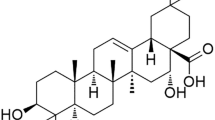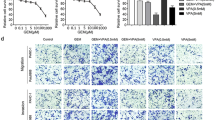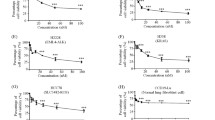Abstract
Valproic acid (VPA) as a broad-spectrum inhibitor of histone deacetylase, has been used in cancer therapy. Recently, the combination of VPA with other anticancer agents has been considered as a useful and necessary strategy to inhibit tumor growth and progression. The coumarin derivates from natural plants have been shown to be the promising natural anticancer agents. However, no literature is available on the anticancer effects of the combination of VPA and coumarin-3-carboxylic acid (HCCA). Here we show that this combination significantly increases inhibitory effects against the proliferation and migration in highly-metastatic lung cancer cells by inducing apoptosis and cell cycle arrest as well as regulating related protein expressions. Our results indicate that this combination of VPA with HCCA not only enhances the protein levels of Bax, cytosolic cytochrome c, caspase-3 and PARP-1 but also reduces the protein expressions of Bcl-2, cyclin D1 and NF-κB as well as inhibits the phosphorylation and expressions of Akt, EGFR, VEGFR2 and c-Met in the cancer cells. Our results suggest that the combination of VPA with HCCA suppresses the proliferation and migration of lung cancer cells via EGFR/VEGFR2/c-Met-Akt-NF-κB signaling pathways; this combination may have a wide therapeutic and/or adjuvant therapeutic application in the treatment of lung cancer.





Similar content being viewed by others
Abbreviations
- VPA:
-
Valproic acid
- HCCA:
-
Coumarin-3-carboxylic acid
- NF-κB:
-
Nuclear factor κB
- VEGFR2:
-
Vascular endothelial growth factor receptor-2
- EGFR:
-
Epidermal growth factor receptor
- Ly:
-
Ly294002
- Bay:
-
Bay 11-7082
- PARP:
-
Poly(ADP-ribose) polymerase
- Cyto C:
-
Cytochrome c
- MTT:
-
3-[4,5-Dimethylthiazol-2-yl]-2,5-diphenyltetrazolium bromide
References
Blaheta RA, Cinatl J Jr (2002) Anti-tumor mechanisms of valproate: a novel role for an old drug. Med Res Rev 22:492–511
Byun SS, Kim FJ, Khandrika L, Kumar B, Koul S, Wilson S, Koul HK (2009) Differential effects of valproic acid on growth, proliferation and metastasis in HTB5 and HTB9 bladder cancer cell lines. Cancer Lett 281:196–202
Chou YW, Chaturvedi NK, Ouyang S, Lin FF, Kaushik D, Wang J, Kim I, Lin MF (2011) Histone deacetylase inhibitor valproic acid suppresses the growth and increases the androgen responsiveness of prostate cancer cells. Cancer Lett 311:177–186
Colon J, Basha MR, Madero-Visbal R, Konduri S, Baker CH, Herrera LJ, Safe S, Sheikh-Hamad D, Abudayyeh A, Alvarado B, Abdelrahim M (2011) Tolfenamic acid decreases c-Met expression through Sp proteins degradation and inhibits lung cancer cells growth and tumor formation in orthotopic mice. Invest New Drugs 29:41–51
Hudak L, Tezeeh P, Wedel S, Makarević J, Juengel E, Tsaur I, Bartsch G, Wiesner C, Haferkamp A, Blaheta RA (2012) Low dosed interferon alpha augments the anti-tumor potential of histone deacetylase inhibition on prostate cancer cell growth and invasion. Prostate 72(16):1719–1735
Jemal A, Siegel R, Ward E, Hao Y, Xu J, Murray T, Thun MJ (2008) Cancer statistics, 2008. CA Cancer J Clin 58:71–96
Jemal A, Bray F, Center MM, Ferlay J, Ward E, Forman D (2011) Global cancer statistics. CA Cancer J Clin 61:69–90
Jiang Y, Zhang Y, Luan J, Duan H, Yagasaki K, Zhang G (2010) Effects of bufalin on the proliferation of human lung cancer cells and its molecular mechanisms of action. Cytotechnology 62:578–583
Kim S, Lee UJ, Kim MN, Lee EJ, Kim JY, Lee MY, Choung S, Kim YJ, Choi YC (2008a) MicroRNA miR-199a regulates the MET proto-oncogene and the downstream extracellular signal-regulated kinase 2 (ERK2). J Biol Chem 283:18158–18166
Kim YT, Kim TY, Lee DS, Park SJ, Park JY, Seo SJ, Choi HS, Kang HJ, Hahn S, Kang CH, Sung SW, Kim JH (2008b) Molecular changes of epidermal growth factor receptor (EGFR) and KRAS and their impact on the clinical outcomes in surgically resected adenocarcinoma of the lung. Lung Cancer 59:111–118
Kim NH, Kim SN, Oh JS, Lee S, Kim YK (2012) Anti-mitotic potential of 7-diethylamino-3(2′-benzoxazolyl)-coumarin in 5-fluorouracil-resistant human gastric cancer cell line SNU620/5-FU. Biochem Biophys Res Commun 418:616–621
Landreville S, Agapova OA, Matatall KA, Kneass ZT, Onken MD, Lee RS, Bowcock AM, Harbour JW (2012) Histone deacetylase inhibitors induce growth arrest and 16 differentiation in uveal melanoma. Clin Cancer Res 18:408–416
Li GF, Qian TL, Li GS, Yang CX, Qin M, Huang J, Sun M, Han YQ (2012) Sodium valproate inhibits MDA-MB-231 breast cancer cell migration by upregulating NM23H1 expression. Genet Mol Res 11:77–86
Lin TH, Lu FJ, Yin YF, Tseng TH (2009) Enhancement of esculetin on arsenic trioxide-provoked apoptosis in human leukemia U937 cells. Chem Biol Interact 180:61–68
Liu Q, Duan H, Luan J, Yagasaki K, Zhang G (2009) Effects of theanine on growth of human lung cancer and leukemia cells as well as migration and invasion of human lung cancer cells. Cytotechnology 59:211–217
Luan J, Duan H, Liu Q, Yagasaki K, Zhang G (2010) Inhibitory effects of norcantharidin against human lung cancer cell growth and migration. Cytotechnology 62:349–355
Marsden VS, O’Connor L, O’Reilly LA, Silke J, Metcalf D, Ekert PG, Huang DC, Cecconi F, Kuida K, Tomaselli KJ, Roy S, Nicholson DW, Vaux DL, Bouillet P, Adams JM, Strasser A (2002) Apoptosis initiated by Bcl-2-regulated caspase activation independently of the cytochrome c/Apaf-1/caspase-9 apoptosome. Nature 419:634–637
Morelli MP, Cascone T, Troiani T, Tuccillo C, Bianco R, Normanno N, Romano M, Veneziani BM, Fontanini G, Eckhardt SG, De Pacido S, Tortora G, Ciardiello F (2006) Anti-tumor activity of the combination of cetuximab, an anti-EGFR blocking monoclonal antibody and ZD6474, an inhibitor of VEGFR and EGFR tyrosine kinases. Cell Physiol 208:344–353
Munster P, Marchion D, Bicaku E, Lacevic M, Kim J, Centeno B, Daud A, Neuger A, Minton S, Sullivan D (2009) Clinical and biological effects of valproic acid as a histone deacetylase inhibitor on tumor and surrogate tissues: phase I/II trial of valproic acid and epirubicin/FEC. Clin Cancer Res 15:2488–2496
Naumov GN, Nilsson MB, Cascone T, Briggs A, Straume O, Akslen LA, Lifshits E, Byers LA, Xu L, Wu HK, Jänne P, Kobayashi S, Halmos B, Tenen D, Tang XM, Engelman J, Yeap B, Folkman J, Johnson BE, Heymach JV (2009) Combined vascular endothelial growth factor receptor and epidermal growth factor receptor (EGFR) blockade inhibits tumor growth in xenograft models of EGFR inhibitor resistance. Clin Cancer Res 15:3484–3494
Oltvai ZN, Milliman CL, Korsmeyer SJ (1993) Bcl-2 heterodimerizes in vivo with a conserved homolog, Bax, that accelerates programmed cell death. Cell 74:609–619
Ozawa A, Tanji N, Kikugawa T, Sasaki T, Yanagihara Y, Miura N, Yokoyama M (2010) Inhibition of bladder tumour growth by histone deacetylase inhibitor. BJU Int 105:1181–1186
Puri N, Salgia R (2008) Synergism of EGFR and c-Met pathways, cross-talk and inhibition, in non-small cell lung cancer. J Carcinog 7:9
Rassouli FB, Matin MM, Iranshahi M, Bahrami AR, Behravan J, Mollazadeh S, Neshati V, Kalalinia F (2011) Investigating the enhancement of cisplatin cytotoxicity on 5637 cells by combination with mogoltacin. Toxicol In Vitro 25:469–474
Reed JC (1997) Bcl-2 family proteins: regulators of apoptosis and chemoresistance inhematologic malignancies. Semin Hematol 34:S9–S19
Siegel R, Ward E, Brawley O, Jemal A (2011) Cancer statistics, 2011: the impact of eliminating socioeconomic and racial disparities on premature cancer deaths. CA Cancer J Clin 61:212–236
Siegel R, Naishadham D, Jemal A (2012) Cancer statistics, 2012. CA Cancer J Clin 62:10–29
Stennicke HR, Salvesen GS (2000) Caspases—controlling intracellular signals by protease zymogen activation. Biochim Biophys Acta 1477:299–306
Wang CY, Mayo MW, Baldwin AS Jr (1996) TNF- and cancer therapy-induced apoptosis: potentiation by inhibition of NF-kappaB. Science 274:784–787
Wang S, Liu Q, Zhang Y, Liu K, Yu P, Liu K, Luan J, Duan H, Lu Z, Wang F, Wu E, Yagasaki K, Zhang G (2009) Suppression of growth, migration and invasion of highly-metastatic human breast cancer cells by berbamine and its molecular mechanisms of action. Mol Cancer 8:81
Wedel S, Hudak L, Seibel JM, Makarević J, Juengel E, Tsaur I, Waaga-Gasser A, Haferkamp A, Blaheta RA (2011) Molecular targeting of prostate cancer cells by a triple drug combination down-regulates integrin driven adhesion processes, delays cell cycle progression and interferes with the cdk-cyclin axis. BMC Cancer 11:375
West KA, Castillo SS, Dennis PA (2002) Activation of the PI3K/Akt pathway and chemotherapeutic resistance. Drug Resist Updat 5:234–248
Yu P, Liu Q, Liu K, Yagasaki K, Wu E, Zhang G (2009) Matrine suppresses breast cancer cell proliferation and invasion via VEGF-Akt-NF-kappaB signaling. Cytotechnology 59:219–229
Zhang G, Miura Y, Yagasaki K (2000) Induction of apoptosis and cell cycle arrest in cancer cells by in vivo metabolites of teas. Nutr Cancer 38:265–273
Zhang Y, Zhang H, Yu P, Liu Q, Liu K, Duan H, Luan G, Yagasaki K, Zhang G (2009) Effects of matrine against the growth of human lung cancer and hepatoma cells as well as lung cancer cell migration. Cytotechnology 59:191–200
Zhang L, Wang G, Wang L, Song C, Wang X, Kang J (2011) Valproic acid inhibits prostate cancer cell migration by up-regulating E-cadherin expression. Pharmazie 66:614–618
Zhang G, Wang Y, Zhang Y, Wan X, Li J, Liu K, Wang F, Liu Q, Yang C, Yu P, Huang Y, Wang S, Jiang P, Qu Z, Luan J, Duan H, Zhang L, Hou A, Jin S, Hsieh TC, Wu E (2012a) Anti-cancer activities of tea epigallocatechin-3-gallate in breast cancer patients under radiotherapy. Curr Mol Med 12:163–176
Zhang L, Wang G, Wang L, Song C, Leng Y, Wang X, Kang J (2012b) VPA inhibits breast cancer cell migration by specifically targeting HDAC2 and down-regulating Survivin. Mol Cell Biochem 361:39–45
Acknowledgments
This work is supported in part by grant (863) from the Ministry of Science and Technology of the People’s Republic of China to G.Z (2012AA020206), from the Ministry of Human Resources and Social Security of the People’s Republic of China to G.Z, Projects of Yantai University to GZ, Project from the National Natural Science Foundation of China to GZ (No. 30973553), and grants from the Department of Science and Technology of Shandong Province to GZ (ZR2012HM016; 2009GG10002087).
Conflict of interest
The authors declare no conflict of interest.
Author information
Authors and Affiliations
Corresponding author
Additional information
Xin Liu, Linlin Chen and Fujia Sun contributed equally to this work.
Rights and permissions
About this article
Cite this article
Liu, X., Chen, L., Sun, F. et al. Enhanced suppression of proliferation and migration in highly-metastatic lung cancer cells by combination of valproic acid and coumarin-3-carboxylic acid and its molecular mechanisms of action. Cytotechnology 65, 597–608 (2013). https://doi.org/10.1007/s10616-012-9513-7
Received:
Accepted:
Published:
Issue Date:
DOI: https://doi.org/10.1007/s10616-012-9513-7




